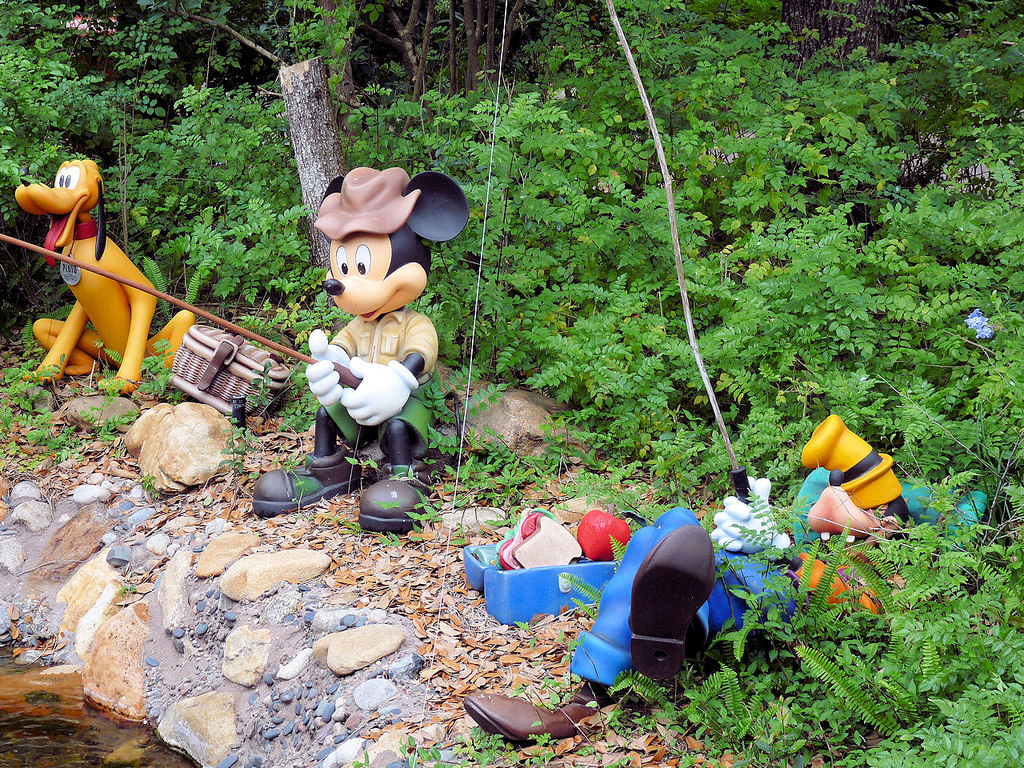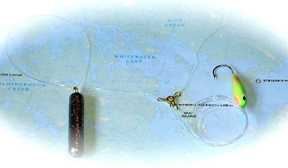
…But you need to find them first
By Chris Clemmons
It seems that every group that goes to Canada has one guy who’s the practical joker or likes to pull funny stunts at some point during the week. In our case that guy is Ted, a gentle giant who, if it hadn’t been for a bum knee, probably would have gone on to play some pro football.
Three years ago six of us were fishing for walleye and pike at one of Wilderness North’s remote outposts. The fishing had been great, as always, and all three boats in our camp arrived at one of our favorite sweet spots to fish together. As we settled in and started to bait our lines, Ted, two boats over, loudly says, “I once was told that just about any old Mickey Mouse rig would work on these lakes.”
We all turned to look and sure enough, Ted pulls a Mickey Mouse pole out of his duffle bag. This thing couldn’t have been more than two feet long and it had a pink jig with a white twister tail tied to the end of the line. We rolled with laughter as Ted (with his five lb. thumb) clicked the tiny button on the reel to release his line and jig to the bottom. The funniest part was that within two jigs of his rod and a flick of his 15 inch wrist, Ted landed a chunky 19-inch walleye.
Four fish and a 23 inch beauty later, the rest of us were doing all we could to keep from going overboard from laughter. Here was a full fledged AARP member the size of an SUV, using a fishing rod the size of his pinky finger and out-fishing the rest of us 3 to 1. That stunt had to be one of Ted’s best but, in truth, once you find the fish you really don’t need to get fancy to catch them in these waters. All you really need is a few dozen assorted jig heads, some twister tails and some miscellaneous plugs.

But you still need to find the fish before you can catch them and sometimes that can take a little more finesse, even in Canada. It’s easy to forget that 80% of the fish inhabit only about 20% of the water. Looking at it from that perspective, if you’re fishing a 26,000 acre lake like Whitewater, that gives you about 5,200 acres of productive water to fish and roughly 20,800 acres of unproductive water. That’s a whole lot of unproductive water that you could waste time fishing in.
Most of us only have three to six days to fish so we want to find the fish fast so we can spend the rest of our trip relaxing and, most importantly, catching. So how do you eliminate unproductive water quickly and narrow in on the best spots to fish?
You don’t just drive the boat out to the middle of the lake and start fishing. You look for some kind of structure that’s likely to attract fish, such as points, reefs, weeds, island clusters, sand flats or current flow.
These are great places to start your search but there’s still more to it than that. When you find a “good-looking” spot, you still have to find the spot-on-the-spot. In other words, the sweet spot on the structure that most of the fish will be relating to.
This can take more time than you think because, similar to the 80/20 rule of thumb for the overall lake, 80% of the fish on any given structure usually only relate to about 20% of it. This is especially true in July, August and early September when fish are in tighter schools relating to deeper structures.
To put it in a nutshell, mid and late summer fish can be a challenge to find but once you do find them, the fishing can be the best of the season. One of the biggest mistakes summer anglers make is to just simply find a good-looking spot, drop the anchor and start fishing. They may, in fact, find the best structure on the lake but drop their anchor 30 to 50 yards from the sweet spot and never get a bite.
When you find a good looking structure, use your motor as a tool for searching. Move, search, and fish, all at the same time. This will help you eliminate the 80% of unproductive structure and find the more productive 20% faster.

Here are some mobile presentation techniques used by pro anglers to find the deep, 15 – 40 foot, spot-on-the-spot and hone in on great action quickly. Also, because we’re talking about mid to late summer and deep water, these are a great ways to find trophy pike as well.
One good presentation choice is to forward troll crank baits. This can be a good way to find loose schools of fish while searching a large flat area in 12 to 20 feet of water. An SR9 Shad Rap or DHJ12 Deep-Diving Husky Jerk in silver, blue or fire tiger are good choices. Slowly troll, at idle speed or slightly faster, with about 75 to 120 feet of line let out behind your boat. You’ll know you are at the right speed when your rod tip vibrates from the lure’s action and you’ll know you have the correct amount of line out when your lure ticks the bottom every so often.
A second option, and my personal favorite for finding the sweet spot on smaller structures, is to back troll a three-way rig. This will give you a more pinpoint presentation than forward trolling crank baits and it will keep your lure in the strike zone longer. So often in summer and early fall, we’ll find the fish tightly bunched on a tiny piece of a large structure. The three-way rig will help you find that tiny spot quickly– here’s how to do it:
First, you want to run 10 to 12Lb. test mono or fire line as your main line from your reel. (Always be sure that the main line from your reel to the rig is the strongest, then if you get snagged, you won’t lose the whole rig and have to retie everything.)
Next, tie on a size 2 – 1/0 three-way swivel.
Then add a 12-24 inch dropper line of 6 to 8Lb. test mono and, depending on the depth you plan to search, tie a ¾ – 2oz weight to the end of your dropper line. (Lindy’s No-Snagg Sinkers, a pencil sinker or bell sinker all work well for this rig.)
Then, tie a 36-48 inch leader of 8-10Lb. Berkley Vanish Fluorocarbon or monofilament line to the three-way swivel.
And finally, for the meat and potatoes portion of the rig, add a J7-J9 jointed Rapala, a size 1 to 2 Gum-Drop floating jig w/ live bait, or a Northland Baitfish Float’n Spin Harness & night crawler.
After you’re rigged, find one of those good-looking structures that we talked about earlier and locate the deeper water surrounding it. (Depending on the spot and the lake, the deep water could range from 20 to 50 feet.) Now, put your motor in reverse and start to back troll your three-way rig. Use your motor’s gear-shift lever to kick the motor in and out of gear to maintain bottom contact with your sinker. (For optimal control of your rig, try to keep your main line at a 35 to 45 degree angle in the water.) Methodically back troll your rig back & forth in an “S” pattern around the structure. Slowly work your way shallower, while keeping an eye on your locator for fish.
When you see a nice pod of fish on your locator and get a strike, immediately throw a marker out, turn the boat around and make a couple more passes with your rig. If you get bit a couple more times, chances are you’ve found the elusive spot-on-the-spot. Now’s the time to drop your anchor and vertical jig, cast or run a slip bobber. It won’t really matter what lure you use because you’ve done your work, found the fish and, at this point, “any old Mickey Mouse rig will work.”
This document has been brought to you by the fly-in fishing experts at Wilderness North – Canada’s premiere destination for walleye and pike trophy fishing.
Wilderness North
Thunder Bay, Ontario, Canada
Phone toll free: 888-465-3474
www.wildernessnorth.com



